“Horse sense is the thing a horse has which keeps it from betting on people.”—W.C Fields, American comedian, philosopher, actor, juggler, writer, pal of Mae West, and a misanthropic, hard-drinking self-aggrandizer, who remained a well-loved character despite him presenting contempt for children and dogs.
The well-known fact: People are passionate about horses and horse racing.
A short while spent in the company of any classy equine and curiosity quickly morphs into passion and possessiveness and then, into possessing one horse, if not more, or many.
Question that?
So did the Queen of Sheba, until she traveled with many camels to meet the Hebrew (notably wise) King Solomon who, like us, had been bitten by the equine-passion-bug. He had horses—a lot of horses—brought out of Egypt post-marrying a daughter of the Pharaoh.
So, Queen Sheba headed off across the desert dragging with her spices, gold, and precious stones. Then, dressing to impress, and with the trappings of wealth, and clearly motivated with intent to “dazzle the king, ” did impress. However, Ole King Solomon did a bit of bedazzling himself.
Sheba’s thoughts on Solomon’s stud farm of a “mere” four-thousand stables that housed forty-thousand stalls, horses, and chariots were: “Howbeit, I believed not the words until I came, and mine eyes had seen it, and behold the half was not told me!” Harness Racing Vehicles, (an anthology) by Susan Green, Librarian p. VII.
So, dear horsemen, next time someone casts shade on your “extravagant hobby of racehorse acquisitions,” weaponize that little tidbit from history and reply, “I only have thirty; Solomon had over forty-thousand. Don’t judge!”
Fast forward to the 5th and 6th century B.C’s chariot games—the forerunner of today’s harness racing.
Chariot racing was an integral part of ancient Greece and played out in the Olympic Games. In Rome, Italy, the vehicle of choice was a light, wood-framed chariot, with leather covering the frame, and a webbed-woven, leather floor that provided shock absorption. The front of the chariot was at a height just above the driver’s knees.
The vehicles were constructed to withstand the rigors of flat out galloping, tight turns in the coliseum, and overly aggressive drivers hell-for-leather driving four or two side-by-side harnessed horses.
harnessed horses.
However, saboteurs sabotaged poorly guarded opponents’ race vehicles. For instance, a steel wheel pin would be switched with a wax pin. The wax pin would hold the wheel in place until the heat of the race melted the wax. The fail sent wheel, chariot, and driver crash-flying.—History channel
“The sport was as organized as harness racing is today with pedigrees of horses being kept, betting, loyal spectators, starting gates, rules and regulations and noted drivers with famous charioteers having statues made of them.”
Across the way (now present-day Turkey), “The ancients [in harness racing] were so passionate about their sport that rivalry between groups of spectators at chariot races often ignited urban riots. In Constantinople, in 532 A.D., a three-day [horse race] disturbance left 30,000 [people] dead.” Harness Racing Vehicles, p. 1.
Essentially, harness racing fans’ passion and competitiveness ignited so furiously and ferociously that 30K fans were canceled. Culture canceling at its most extreme.
All across the Mediterranean, charioteer gladiators, the forerunner of today’s sulky drivers, were heralded as heroes and monumentalized in marble. It brought the fans and filled the stands.
Hmmm, bronzed monuments of Tim Tetrick, Yannick Gingras, and Dexter J. Dunn standing in Pennsylvania’s infields? Sulky racing’s “Field of Champions for Selfie Shots” commemorating 2019’s biggest winners. Build it, and they will come? There’s a thought.
America: The Land of Free-Spirited Competitiveness
Across the pond from Europe in the United States during the 1800s, as per the census of 1850, over 4.5 million horses (not counting city-horses) populated the countryside in proportions of one horse per five persons. Pennsylvania equines counted up to a tally of one horse to approximately six people. New York had a 1:7 ratio, Kentucky 1:3 (free inhabitants), and Ohio 1:4. Harness Racing Vehicles, p. XI.
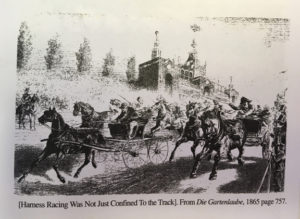
With American’s free-spirited, ever-competitive mentality, harness racing commonly broke out on dirt roads and lanes at the snap of a sideways glance. Four-wheeled, nailed together, large wooden-spokes buggies raced against two-wheel governess carts against Phaeton carriages against farm wagons.
Winter races pitted drivers of cutter sleighs against one-horse sleighs. In some cases, wrecked chaos in sued i.e. reference the Christmas carol: “one-horse open sleigh . . . and then we got upsot.”
Despite steel nail connectors being encapsulated within the wooden spokes’ wheels, and over-wrapped with metal, the nails tore and ground at the wood resulting in structural failure and wrecks.
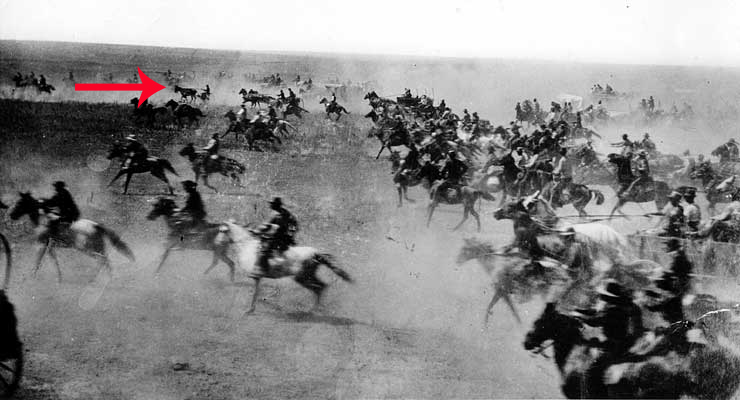 Think too of the Oklahoma Land Rush [race] of April 22nd 1889 where 50,000 people lined up afoot, on horseback, and with every imaginable “modern” horse-drawn vehicle, including harnessed “race” bikes with all running, for their piece of the available two million acres (8,000 km).
Think too of the Oklahoma Land Rush [race] of April 22nd 1889 where 50,000 people lined up afoot, on horseback, and with every imaginable “modern” horse-drawn vehicle, including harnessed “race” bikes with all running, for their piece of the available two million acres (8,000 km).
At high noon a military cannon boomed—possibly the origins of the “Annd they’re off” cry.
Then We Get Civilized Via American Ingenuity & Innovation
Meanwhile, professional harness racing in America was evolving as an organized sporting event, and with it, the advent of the proper sulky racing bike.
One Wheel Sulky
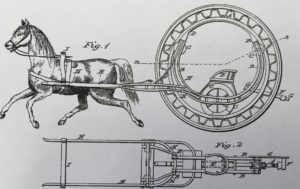
One of racing’s most unique bike was the one wheel sulky. Originally thought to have sprung from the necessity of driving a horse through growing, rowed crops without infringing upon and thus damaging the crop; it was soon to find its way onto the horse race track. “It was projected to offer increased speed . . . and a decrease in the chance of an accident.” —Harness Racing Hall of Fame
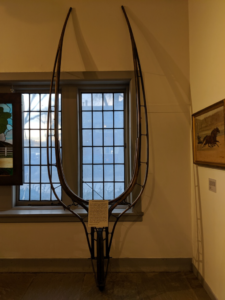
The central location of the wheel (positioned directly under the driver’s seat) was believed to enhance the driver’s balance. From 1870 to 1904, there are patents for eleven variations of the one wheel sulky.
Amusingly, however, this 1870’s invention and patent, along with several others’ patented versions were apparently unbeknownst to Carriage Monthly, who reported 24 years later, in their February 1894 issue, “Capt. Alphonse B. Smith, a pioneer of San Diego, California, is the inventor of a one-wheel sulky, which apparently is a success.”
The Equine Bicycle
Meanwhile, in 1891, another racing conveyance was making its debut appearance in NYC: The Equine Bicycle.
“It involves a mechanical principle which could be developed into an ideal vehicle for a speeding trotter,” the Hub reported in its March issue.
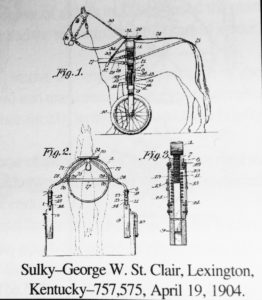

“It’s a remarkable-looking affair, and enough to scare any self-respecting horse that meets it on the road,” reported the Hub. “By a careful examination, it will be seen that the driver is carried without weighting the horse, with the least possible draught, and that the dragging-back friction of the curves of the course is entirely overcome.”
There are at least 11 variations of the bicycle sulky that were patented starting in 1881, with the idea still producing an additional patent in 1904. Harness Racing Vehicles, p. 54-55.
The Wooden Two-Wheeled Sulky
Before the introduction of the rubber-coated wheel, (and then, the evolution to the pneumatic tire wheel), the wooden wheeled two-wheeled sulky was constantly under scrutiny for improvements. There are 25 patented improvements between 1870 and 1876 with design improvements in shafts, couplings, seats, wheels, springs, and axles.
There are incredible designs patented and put into use and put to the test at the races of sulkies in numerous and varied heights, shaft lengths (including a single shaft vehicle), unique seating placements, and all with materials as varied as the imagination using aluminum, tubular steel, and solid metals. Between 1882 and 1890, thirty-five patents are registered.
In one design, ash and hickory was fashioned into a “split-shaft” combining the flexibility of ash with the safety feature of hickory’s strength. The idea being that if the ash failed, the strong hickory would hold true and prevent a complete shaft failure and the subsequent crash. Axles were arched and angled and straight, solid, and jointed.
Enter the Pneumatic Tire Sulky
With the development to pneumatic wheels, all bets were in, as were the numerous innovators and inventors who invested in designing and producing all variations conceivable towards the best, strongest, and fastest sulky bike.
“Who first thought of putting pneumatic tires on a trotting sulky is not definitely known. There is no dispute, however, as to priority in practical application of the idea. It is conceded that Sterling Elliott of the Elliott Hickory Cycle Company of Newton, Massachusetts was the first to apply bicycle wheels to sulkies.” Harness Racing Vehicles, p. 7.
As the story goes, on “June 8, 1892 the old-style sulky was sent to Worcester [track] with its large wheels on, and [I, Sterling Elliott] carried the small wheels in a bag, as I didn’t care to hear the remarks which were sure to be made. While I was putting on the little wheels, I was surrounded by an interested circle of stablemen and drivers, whose comments you could hardly print in the Hub.”
Jud Woodbury, who had after driving it before-hand on a private track well ahead of the race said, “If I were going into a race for my life I would take that gig in preference to anything I ever saw.”
Later as Sterling Elliott continued in the telling of his story to the editor of Hub, “When he got into the sulky at Worcester, he was probably the only man who would have cared to stand the ‘haw haws’ of the crowd in the new rig. When he won the first heat, there was a decided change in the temperature of the audience, and when he had won the race (four heats), I began to have inquiries from horseman as to where they could ‘buy one of the d— things.” –Harness Racing Vehicle, From a letter by Sterling Elliott to the editor. “The Sulky Builder.” Hub (June 1904), p. 117.
That success paved the way and solidified the pneumatic tire’s place (at least to date) as the preferred wheel choice in sulky bikes. Innovations continue into the current day with adjustments, adaptations, and inventions for improvements with axles, seats, seat positions, materials, and design.
“To learn about the people of antiquity is to examine the foundations of how we live today. They are at once alien and familiar, an image of ourselves glimpsed in a distant mirror.”–Dr. Garrett G. Fagan, Professor of Ancient History at the Pennsylvania State University
_______________________
To learn more, visit the Harness Racing Museum & Hall of Fame in Goshen, NY. Visitors will see many of the unique experiments in speed racing bikes that have evolved over the years from the extensive collection on display. The Harness Racing Museum & Hall of Fame is dedicated to comprehensive, active and authoritative support and promotion of the Standardbred industry through documentation and preservation of the history and traditions of this American-born sport.
Contact Harness Racing Hall of Fame: 845-294-6330
Email: info@harnessmuseum.com
The PHRA would like to thank: Susan Green, author of Harness Racing Vehicles; Janet Terhune, Director of Harness Hall of Fame; Rebecca Howard, Collections Curator at Harness Hall of Fame; and Paul Wilder, Library Collections at Harness Hall of Fame. Without their gracious and generous contributions, this story would not be possible.
* Numerous images presented are from the Carriage Room Gallery of the Harness Racing Museum & Hall of Fame, Goshen, New York. The Carriage Room, once the storage area for the stable’s horse-drawn vehicles, is now a multi-use art and exhibit gallery. On display is a variety of vehicles showcasing the progression and inventive styles that have aided the advance of speeds reached by the sport’s equine champions.











